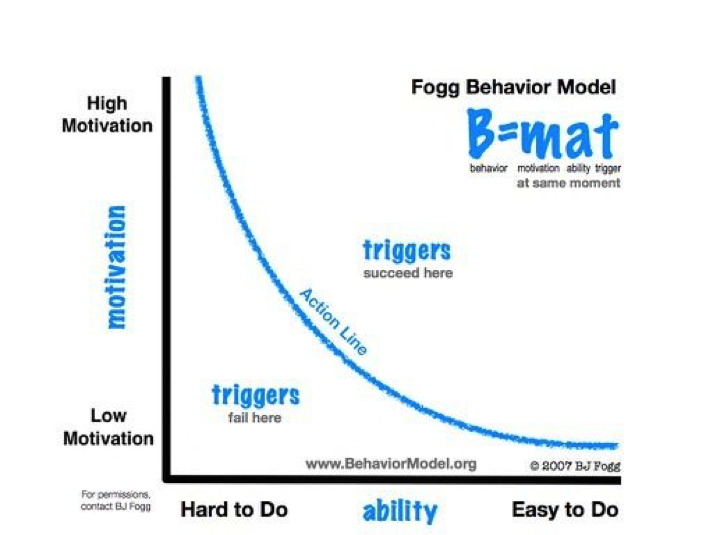Written by: Gabriel Goh, Gamification Designer
This is an interactive article and I would like to invite you to take part in this – creating behavioural change in yourself.
Everyone longs for change. When I say change, it refers to a desirable change. For instance, John has been overworked doing everything by himself and he needs to learn to delegate his tasks to others. However, not everyone is willing to commit to change, simply because they think it is hard.
Before we talk about creating behavioural change, let us take a step back, how does an individual’s behaviour change occur? According to Fogg’s Behaviour Model, behavioural change occurs when the 3 components, namely Motivation, Ability, and Trigger are present at the same time.
Behavioural change = Motivation x Ability x Trigger
Before we dive into the components separately, here is my first question to you:
“What is the ONE behavioural change you would like to see in yourself?”
Motivational
According to Fogg, there are 3 types of motivations, which are physical, emotional and social motivations. Let’s take John as an example and I will demonstrate how to apply gamification in the journey of delegating tasks. If you are wondering what gamification is, basically it is the use of game elements in non-game applications (in this case, to stop overworking) to keep you motivated and engaged in the task.
Physical
From my point of view, another term for physical motivation is extrinsic motivation. As human beings, we have the tendency to seek pleasure and avoid pain. Hence, we are inclined to do certain actions only if we know we will be rewarded. Tying back to the example, in order to make sure John starts delegating his tasks, we can reward him by offering tangible rewards that act as instant gratifications, such as free vouchers for a romantic getaway with his loved one, lunch opportunities with a CEO, etc.
Emotional
From my point of view, emotional motivation refers to intrinsic motivation. According to Growth Engineering, hope is the most powerful motivator in making sure learners are engaged in the task. For instance, give him an Epic Meaning for delegating tasks. What does it mean to him if John changes his current behaviour? By doing so, it gives him a sense of purpose in taking part in something that is meaningful to him.
On the other hand, we could also use fear as another emotion to make sure that he is on track. For instance, we could leverage his fear of burning out mentally, fear of physical exhaustion, etc. Remember why was it so effective when your parents banned you from watching TV or eating dessert if you did not do what they wanted you to do? They utilised your fear of being deprived of the things that you desire as a “motivation”. It can normally be seen in games like Monopoly. For you to win, you need to keep yourself from falling into bankruptcy.
Social
Social motivation is also known as the motivation for belonging. According to Maslow’s Hierarchy of Needs, a sense of belonging is a basic human need and we cannot survive without it. This explains why prisoners are punished by being placed into solitary confinement as this is against human’s instinct to live alone.
Hence, it is common to see a lot of game developers create games that allow players to compete against or cooperate with one another. Besides that, they also include social elements into their games, such as leaderboards, forums, etc.
If John is motivated by having a sense of belongingness and relatedness, you can invite him to join a focus group where he could connect and share stories with colleagues or peers who have had a similar experience.
Here is another question for you: “What motivates you the most?”
Ability
In this model, the ability doesn’t refer to someone’s competency for a particular task. Fogg defines ability as to how simple it is to do a certain task. Simplicity is the key here as the more complicated a task is, the more motivation is required. Here are the 6 key elements that you should take note of when you are minimising your task. Before you proceed to the next question, do check out Fogg’s “Six Elements of Simplicity”.
If John was told to delegate all of his tasks on the very first day, it would seem almost impossible for him. As a result, he might not even start to change as the stakes are too high. It would be so much easier if the task is broken down into parts. Firstly, start with delegating 20% of his tasks, followed with 40%, 60% and so on.
“How would you make your task simpler?”
You’re almost there……
Trigger/Prompts
One last step. If we want to break out from our old lifestyles and achieve something new, we will need a reminder as a trigger. For instance, place post-it notes on your desktop or ask someone to be accountable for your change. As for John’s example, we could ask him to declare the changes he is going to make in front of his colleagues so that they can hold him accountable of his actions by reminding him from time to time.
Here is my last question for you: “What will you be using as your trigger?”
Or, “Who will hold you accountable?”
In a nutshell, make sure that the changes you want to implement really matters to you (motivation), the behaviours are as simple as possible (ability) and prompt yourself to take action in the right way (motivation). Most importantly, find out what keeps you engaged and gamify your process, I can assure you the path towards change is not as hard as it seems anymore.




